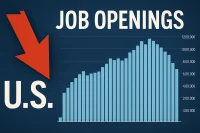The Bureau of Labor Statistics (BLS) released its latest labor market data in early February, revealing two major takeaways:
- The US job market remains strong, with an average of 170,000 jobs added per month over the last six months of 2024.
- Employment numbers were revised downward, cutting 600,000 jobs from previous estimates.
While the overall labor market performed well, revised data showed that white-collar industries—such as tech, finance, and professional services—were hit harder than expected.
The downturn in these sectors was more severe than previously believed, reinforcing concerns about a white-collar recession.

The Impact of the Benchmark Revision
Each January, the BLS updates payroll employment figures based on more accurate population data from the Quarterly Census of Employment and Wages (QCEW). This annual benchmark revision ensures the labor market numbers better reflect reality.
As expected, the February jobs report revised nonfarm payroll jobs down by 600,000, indicating the labor market was not as tight as previously thought.
However, despite these corrections, the US economy still added over two million jobs in 2024.
Which White-Collar Sectors Were Hit Hardest?
Research from Recruitonomics found the revisions revealed certain white-collar industries saw more job losses than initially reported:
- Information and Communication – Originally thought to be stable at 3 million jobs, this sector actually fell to 2.95 million by early 2024.
- Professional and Business Services – Employment was expected to grow slowly, but revised data shows a decline of 150,000 jobs since early 2023.
- Financial Activities – Previous reports suggested moderate job growth, but new figures reveal stagnation since mid-2023.
Altogether, these three white-collar sectors accounted for 80% of the 600,000 downward revision, meaning the downturn in professional employment was far worse than initially thought.
A Global Trend: White-Collar Recession Beyond the US
The white-collar downturn is not limited to the U.S.—it is affecting major economies worldwide.
- France – The information and communication sector expanded rapidly between 2020 and 2022 but has lost jobs since early 2023.
- Germany – Tech employment grew from 1.4 million in 2020 to 1.55 million in early 2023, but growth has stalled ever since.
- United Kingdom – White-collar employment surged post-pandemic but has since declined by 50,000 jobs in the last two years.
These trends suggest that the white-collar recession is driven by global factors such as rapid post-pandemic hiring, inflation control measures, and over-expansion in tech and finance.
Hiring? Post jobs for free with WhatJobs
Expert comment
Alex Paterson, WhatJobs CEO, said:
“The latest labor market revisions confirm what many professionals have been feeling for some time—white-collar job security is no longer a given. The downward adjustment of 600,000 payroll jobs, with the majority coming from tech, finance, and business services, highlights a shift in how companies are hiring and restructuring their workforces.
“At WhatJobs, we’ve seen a growing number of skilled professionals looking for new opportunities in a more competitive environment. The challenge now is not just finding jobs, but adapting to a market that increasingly values specialized skills over traditional credentials.
“Job seekers need to be proactive, upskilling where possible and exploring alternative career paths in growing industries. The days of steady, predictable white-collar employment are fading, and those who embrace change will be best positioned for long-term success.”
Need Career Advice? Get employment skills advice at all levels of your career
What Comes Next?
The labor market revision confirms that the white-collar recession is real and deeper than expected. While other industries continue to grow, many professional jobs have disappeared, leaving workers uncertain about future opportunities.
With hiring slowing and layoffs increasing in key industries, white-collar professionals will need to adapt to a changing job market. The question now is whether these job losses are temporary—or a sign of a permanent shift in the workforce.
FAQs
What is the white collar recession?
A white-collar recession refers to a downturn that disproportionately affects office-based, professional jobs rather than traditional blue-collar roles like manufacturing or construction. It typically involves layoffs, hiring freezes, and wage stagnation in sectors such as finance, tech, law, and consulting. Unlike a standard recession, which impacts the economy broadly and often hits lower-wage jobs first, a white-collar recession primarily affects higher-skilled, salaried workers.
Several factors can trigger a white-collar recession, including automation, artificial intelligence, corporate cost-cutting, and economic shifts that reduce demand for high-paying professional roles. Recent downturns have been driven by overhiring during boom periods, tech sector layoffs, and rising operational costs. The industries most affected tend to be technology, finance, media, and professional services, particularly when companies restructure or cut back on non-essential roles.
To protect themselves, professionals can focus on building in-demand skills, expanding their networks, and maintaining financial security. Upskilling in areas like AI, cybersecurity, and data analysis may improve job prospects. Many experts believe the current job market is experiencing a white-collar recession, with widespread layoffs and slowing hiring in professional sectors, particularly in industries that overexpanded in previous years.
What is a white collar job example?
A white-collar job typically refers to professional, office-based work that requires specialized skills, education, or training. These jobs are generally salaried rather than hourly and involve mental rather than physical labor.
One common example is a financial analyst. Financial analysts work in banks, investment firms, and corporations, evaluating market trends, company performance, and financial risks to help businesses make informed investment decisions. They analyze data, prepare reports, and provide strategic recommendations based on financial models.
Other white-collar roles include software engineers, who design and develop applications and systems; marketing managers, who oversee branding and advertising strategies; and accountants, who manage financial records and ensure compliance with tax regulations. Lawyers, doctors, consultants, and human resource professionals also fall under the white-collar category.
Unlike blue-collar jobs, which often involve manual labor in fields like construction, manufacturing, and maintenance, white-collar work is usually done in office settings, using computers and other digital tools. With the rise of remote work, many white-collar jobs can now be performed from home. These positions often require at least a bachelor’s degree, though some fields emphasize experience and certifications over formal education. White-collar jobs are generally associated with stability, career growth, and higher earning potential.
What is the blue-collar economy?
The blue-collar economy refers to industries and jobs that involve manual labor, skilled trades, and hands-on work, often in fields like manufacturing, construction, transportation, and maintenance. These jobs are typically paid hourly rather than salaried and may require vocational training, apprenticeships, or on-the-job experience rather than a traditional college degree.
Key sectors within the blue-collar economy include construction, where workers build homes, roads, and infrastructure; manufacturing, which involves producing goods in factories; and logistics, which includes truck drivers, warehouse workers, and supply chain management. Other examples include electricians, plumbers, welders, and mechanics—roles that are essential for maintaining everyday infrastructure and services.
The blue-collar economy is critical to economic stability, as these jobs support industries that keep society functioning. Despite automation and outsourcing reducing some traditional roles, demand remains strong for skilled trades due to ongoing infrastructure projects, housing development, and supply chain needs. Wages for many blue-collar jobs have increased in response to labor shortages, and some positions now offer competitive pay and benefits without requiring a four-year degree.
With advancements in technology, the blue-collar economy is evolving, integrating automation, robotics, and specialized training to improve efficiency and productivity while still relying on human expertise.




